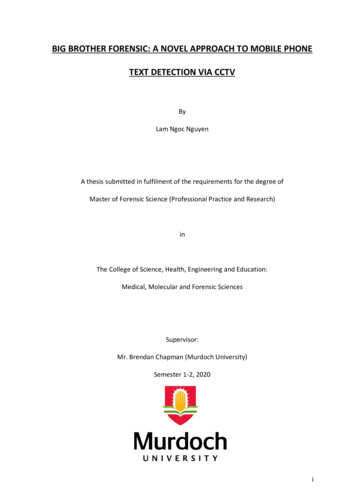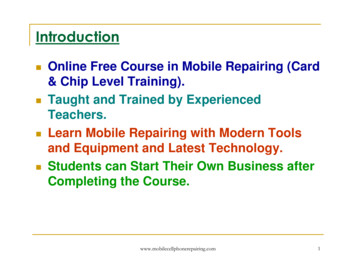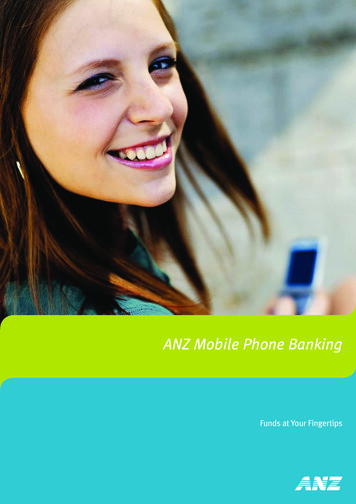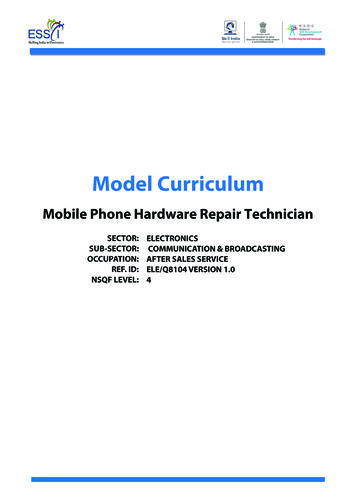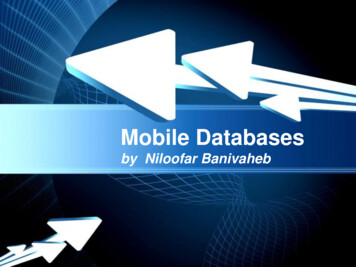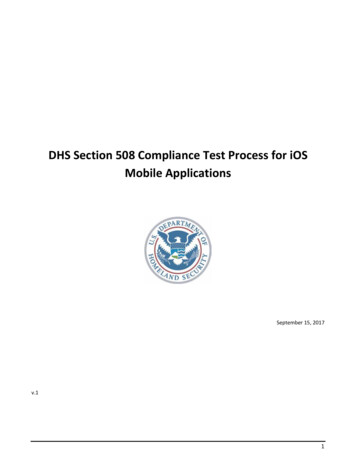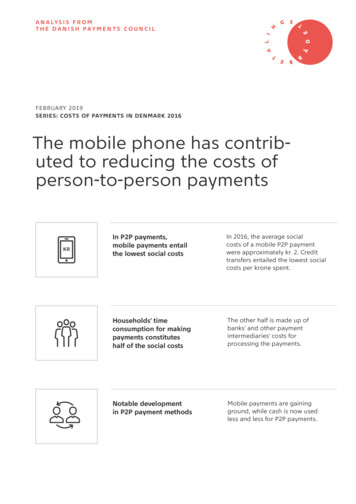
Transcription
A N A LY S I S F R O MTHE DANISH PAYMENTS COUNCILFEBRUARY 2019SERIES: COSTS OF PAYMENTS IN DENMARK 2016The mobile phone has contrib uted to reducing the costs ofperson-to-person paymentsIn P2P payments,mobile payments entailthe lowest social costsIn 2016, the average socialcosts of a mobile P2P paymentwere approximately kr. 2. Credittransfers entailed the lowest socialcosts per krone spent.Households’ timeconsumption for makingpayments constituteshalf of the social costsThe other half is made up ofbanks’ and other paymentintermediaries’ costs forprocessing the payments.Notable developmentin P2P payment methodsMobile payments are gainingground, while cash is now usedless and less for P2P payments.
A N A LY S I S F R O M T H E D A N I S H P A Y M E N T S C O U N C I LT H E M O B I L E P H O N E H A S CO N T R I B U T E D TO R E DU C I N G T H E CO S T S O F P E R S O N - TO - P E R S O N PAY M E N T SThe Danish Payments Councilhas surveyed the social costs ofpayments in DenmarkThe Danish Payments Council1 has surveyed the soci al costs of payments in Denmark. This analysis is partof a series of analyses and for the first time presentsthe social costs of domestic payments between pri vate individuals, i.e. P2P payments2.Social costs express the aggregate use of resourcesby the parties involved in a payment transaction, i.e.payment intermediaries, the payer, and the payee,cf. Box 1. Social costs do not comprise transfersbetween the parties, such as fees, as they constitutean ex pense for one party and income for the other.Consequently, the social costs do not say anythingabout e.g. the possible fee for withdrawing cash orthe annual fee for holding an international credit card.The Danish Payments Council’s survey of the costsof payments gives payment market participants andother stakeholders insight into the social costs ofvarious types of payment.P2P paymentsDenmark has a well-functioning payments marketwhere private individuals have a choice of paymentmethods, depending on the payment situation. P2Ppayments include all transfers of money betweenprivate individuals, whether in the form of gifts,pocket money, purchases at garage sales or forother purposes.In 2016, some 180 million P2P payments were madeusing the most frequent methods of payment. Thethree most prevalent payment methods for P2Ppayments are mobile payments, cash and credittransfers via online or mobile banking. All three arecomprised by this analysis, cf. Chart 1.1The Danish Payments Council is the framework for collaboration onthe payments of consumers and businesses. The Council was set upby Danmarks Nationalbank and includes representatives of a broadrange of stakeholders in the Danish payments infrastructure.2P2P stands for Person-to-Person.Social costs2Box 1P2P payments are made every day all year round. Thecalculation of the social costs of making a P2P paymentincludes elements from both households and paymentintermediaries. Payment intermediaries are banks andcash-in-transit (CIT) companies, among others.Each party incurs costs when executing a payment. Thesecosts are either internal resource costs, such as the timeit takes the payer to complete a payment, or transfers toother parties, such as a bank’s transfer to a CIT company.This analysis reviews the social costs, i.e. the aggregateuse of resources by the parties involved in a payment.Transfers between the parties have been excluded.For payment intermediaries, the resource costs relate topayroll costs for employees such as cashiers, as well asexpenses for equipment, e.g. IT systems.For households, the resource costs of a payment relateto the opportunity cost of the time a payment takes.This means that the cost is not money to be paid by thehouse holds, but rather a reflection of the value of thetime the households spend making payments.The basis for the survey is an extensive data collectionfrom households and businesses via questionnairesurveys, as well as direct collection from selected banksand other payment intermediaries. The household surveywas conducted in the spring of 2017, but is referred toas 2016 in the analysis as this is the reference year forthe other data. For further details, see the website of theDanish Payments Council (link), where a description ofthe method and the other analyses in the series can befound.
A N A LY S I S F R O M T H E D A N I S H P A Y M E N T S C O U N C I LT H E M O B I L E P H O N E H A S CO N T R I B U T E D TO R E DU C I N G T H E CO S T S O F P E R S O N - TO - P E R S O N PAY M E N T SHouseholds mainly use three methods of payment when making P2P payments3Chart 1Mobile paymentsCashCredit transfersNote:Credit transfers are P2P payments via online or mobile banking. Note that mobile payment is a service for initiating other methodsof payment (card payments and credit transfers), but nevertheless it is treated separately in this survey as the payment experienceis different from the underlying methods.P2P payment costs amountedto almost kr. 500 millionThe aggregate social costs of P2P payments werealmost kr. 500 billion in 2016, cf. Chart 2. That isequiva lent to around 0.02 per cent of GDP. A P2Ppayment involves not only the households makingand receiving the payment, but also payment inter mediaries. Depending on the payment method,payment intermediaries are banks, card companies,etc., CIT companies and Danmarks Nationalbank.The households’ resource costs make up around halfof the social costs of P2P payments. These comprisethe time spent making payments, checking accountstatements and withdrawing cash. The households’time is included as a social cost because this timecould otherwise have been spent productively, e.g.for work.The other half of the social costs of P2P paymentsis made up of the payment intermediaries’ re sourcecosts, i.e. payroll costs for employees, costs forequipment and IT systems, and losses in connectionwith fraud.The social costs of P2P paymentsamounted to almost kr. 500 millionSocial costs,kr. oldsP2P paymentsSource: The Danish Payments Council.Chart 2
A N A LY S I S F R O M T H E D A N I S H P A Y M E N T S C O U N C I LT H E M O B I L E P H O N E H A S CO N T R I B U T E D TO R E DU C I N G T H E CO S T S O F P E R S O N - TO - P E R S O N PAY M E N T SMobile payments are the most inexpensive P2P payment method for societySocial costs,kr. per paymentCashChart 3No. of payments,million4.0Credit transfersMobile payments45.02.11342450100Note:The hatched horizontal bars indicate that the numbers of cash payments and credit transfers are subject to uncertainty. However,this does not affect the cost per payment. In the chart, credit transfers are only those made via online or mobile banking. The costsof P2P payments should not be compared with the costs of C2B payments, as the payment situation and the parties involved differ.For example, P2P payments do not involve businesses and their resource costs for receiving payment.Source: The Danish Payments Council and MobilePay.Mobile payments are the mostinexpensive P2P payment methodAt an average cost of kr. 2.1 per payment, mobilepayments involved the lowest social costs in 2016, cf.Chart 3. A cash P2P payment cost kr. 4, while the so cial costs of a P2P credit transfer via online or mobilebanking were kr. 5.Payments are characterised by involving relativelylarge fixed costs. Therefore, the number of paymentsfor each payment method has an impact on theaverage cost. 3 out of 4 P2P payments were mobilepayments in 2016, equivalent to around 134 millionpayments. This widespread use contributes to re ducing the average social cost per payment. Conse quently, it is important to keep the prevalence andthe fixed costs of payments in mind when comparingthe different payment methods.payments to private individuals and to retailers. TheDanish Payments Council has also surveyed the so cial costs of consumer-to-business, C2B, payments.3In a cash transaction, for example, a private indi vidual can simply pocket the cash and use it later.A retailer, on the other hand, has a cash registerand must among other things take excess cash tothe bank, and the cost structure is therefore entire ly different. Nor is a mobile payment to a privateindividual comparable to e.g. a Dankort payment ina retail store.Although some payment methods involve highersocial costs per payment than others, there may stillbe good reasons to use them. The calculation of thepayment costs covers the actual payment situationonly and thus not any other reasons there might befor choosing a specific payment method.When calculating the social costs, it is important tobe aware that there are major differences between3See Danish Payments Council, The costs of consumer-to-business pay ments have decreased considerably, Danish Payments Council Analysis,September 2018.
A N A LY S I S F R O M T H E D A N I S H P A Y M E N T S C O U N C I LT H E M O B I L E P H O N E H A S CO N T R I B U T E D TO R E DU C I N G T H E CO S T S O F P E R S O N - TO - P E R S O N PAY M E N T SThe resource costs of the partiesdepend on the method of paymentThe resource costs of both payment intermediariesand households varied somewhat, depending onthe P2P payment method, cf. Chart 4.The social costs per payment incurred by paymentintermediaries were approximately twice as high forcash P2P payments as for the other two methods ofpayment. This is attributable to the physical natureof cash; it must be produced and handled, whichinvolves social costs.The payment intermediaries’ social costs per pay ment were lowest for credit transfers and slightlyhigher for mobile payments. This is because in manysituations a mobile payment involves not only acredit transfer but also a card payment, cf. Box 2.The households’ social costs per payment variedconsiderably, depending on the method of payment,cf. Chart 5. The costs were lowest for mobile pay ments and highest for credit transfers. The costs forcash were about midway between the two. For households, the social costs are the opportunity costslinked to the time spent making payments, includ ing the time consumption for withdrawing cash andchecking account statements.For cash payments, household costs are to a largeextent the time spent withdrawing cash. Time is alsospent making the payment, while checking the ac count statement plays a smaller role as the individualpayments are not listed in the account statement.For credit transfers there is, of course, no time con sumption for withdrawing cash. On the other hand,more time is spent checking account statements, aspayments are entered individually to the account.The actual payment time is also considerably longerfor credit transfers. This is due to the need to logonto the mobile or online banking solution to makea credit transfer and also to state an account numberand perhaps approve the transaction using NemID4.For mobile payments, the payment time is similarto that for cash payments, but the distribution onpayer and payee is not the same. For the payer, it4NemID is a Danish common secure two-factor login solution used fordigital signatures in a multitude of public and private institutions.Use of resources varies withthe method of payment5Chart 4Social costs,kr. per payment543210Mobile paymentsHouseholdsCashCredit transfersPayment intermediariesNote:Payment intermediaries are banks, card companies, etc.,CIT companies and Danmarks Nationalbank.Source: The Danish Payments Council.Mobile P2P paymentsBoks 2In the Danish Payments Council’s survey, the social costsof mobile P2P payments have been calculated on thebasis of data from the Danish mobile payment provider,MobilePay.In 2016, Danish households had a choice of two mobileP2P payment options: Swipp and MobilePay. The pre ferred product was MobilePay, which had more than3 million users at end-2016, while Swipp had around900,000. Swipp was discontinued in February 2017.In 2016, most mobile payments via MobilePay involved acard payment from the payer to MobilePay and a credittransfer from MobilePay to the payee (in certain cases,however, a credit transfer could be made directly fromthe payer to the payee). Hence, MobilePay is a servicefor initiating other methods of payment. Nevertheless,mobile payment is treated as a separate method ofpayment in this survey as the payment experience isdifferent from the underlying methods. Since the surveyresults for mobile payments are based on MobilePay, thenumber of mobile P2P payments is underestimated, asare the aggregate social costs of mobile payments. Butthe average costs per mobile payment and per kronespent are assessed to be accurate.
A N A LY S I S F R O M T H E D A N I S H P A Y M E N T S C O U N C I LT H E M O B I L E P H O N E H A S CO N T R I B U T E D TO R E DU C I N G T H E CO S T S O F P E R S O N - TO - P E R S O N PAY M E N T Stakes longer to make a mobile payment than a cashpayment. But for the payee it takes no time to receivea mobile payment, unlike a cash payment. So ulti mately the time consumption is almost the same forthe two methods of payment.The payment costs of householdsare the time they spendChart 5Social costs,kr. per payment4Large payments make credit transfersmost cost-effective relative to the turnoverThe payments households typically make usingthe various P2P payment methods differ in size.Consequently, it is relevant to compare the socialcosts of the payment methods with the valueof the payments.If a P2P payment in connection with the sale of asecond-hand car has a value of kr. 100,000, it is morejustifiable to incur slightly higher social costs thanwhen two friends split the bill at a restaurant. Andindeed, this is the picture emerging when socialcosts are related to the value of payments using theindividual methods, cf. Chart 6.63210Mobile paymentsCash withdrawalPayment timeCashCredit transfersChecking account statementNote:Cash withdrawals include withdrawals from ATMs, at thecounter in a bank, as well as cashback at retailers.Source: The Danish Payments Council.Relative to the turnover, credit transfers involved thelowest social costs. This is closely linked to the factthat the average value of these payments was byfar the highest. Mobile payments take second place,High-value payments mean that credit transfers entail the lowest costs per krone spentfor P2P paymentsSocial costs,øre per krone spentCashCredit transfersMobile paymentsAverage valueof payment, kr.2.20.30.72841Note:Chart 625001,000The hatched horizontal bars indicate that the numbers of cash payments and credit transfers are subject to uncertainty. However, thisdoes not affect the cost per payment. In the chart, credit transfers are only those made via online or mobile banking.Source: The Danish Payments Council and MobilePay.
A N A LY S I S F R O M T H E D A N I S H P A Y M E N T S C O U N C I LT H E M O B I L E P H O N E H A S CO N T R I B U T E D TO R E DU C I N G T H E CO S T S O F P E R S O N - TO - P E R S O N PAY M E N T SMobile payments are gaining ground for P2P payments7Chart 7Cash paymentsMobile paymentsMillion payments200Million 01620172018Note:The number of cash P2P payments in Denmark has been calculated in 2009 and 2016 only. Data for the number of cash payments in 2016is subject to measurement uncertainty. Hence, the number in the chart is indicative. The number of mobile payments is based on Mobile Pay.Source: The Danish Payments Council, Danmarks Nationalbank and MobilePay.while cash involved the highest costs per krone spent.The high costs of using cash should be viewedin the light of cash having the lowest average valueper payment. Electronic payments, such as credittransfers and mobile payments, are more costeffective for larger payments, as the social costs donot rise with the amount paid. The opposite appliesto cash payments, as more cash must be producedand handled if the amount increases.5 Indeed, cashis used primarily for smaller payments – both in C2Band P2P payments.6Fewer P2P payments in cashIn 2016, cash was used approximately 40 milliontimes for P2P payments, down from almost 150million in 2009, cf. Chart 7. This is a decline of almost75 per cent. In the same period, mobile paymentsentered the Danish payments market. In 2016, theDanes made approximately 134 million mobile P2Ppayments.5See e.g. Danmarks Nationalbank, Omkostninger ved betalinger i Danmark (in Danish only), December 2011. An English summary, Reporton domestic payment transfers in Denmark, was published in January2012. The report collates results from multiple countries, which allfind that the marginal costs of cash payments are increasing.6See Victor Gørtz Smestad, Danish households opt out of cashpayments, Danmarks Nationalbank Analysis, no. 24, December 2017.A questionnaire survey performed by DanmarksNationalbank among Danish households shows thatsome of the preferred characteristics of cash are alsoemphasised in connection with mobile payments.For both payment methods, the respondents saythat they are ”easy to use” and that ”payments aresettled immediately”. These responses show thatthe unique characteristics of cash are no longer sounique, indicating that mobile payments to a largeextent replace cash payments. Therefore, some ofthe 134 million mobile payments in 2016 can beassumed to have replaced cash payments. This hascontributed to reducing the social costs of P2P pay ments.In the same period, mobile banking has also madecredit transfers easier. Access to online banking viaa mobile phone was very limited in 2009, and mobilebanking as we know it today was not launched in theDanish market until 2010. Access to mobile banking
A N A LY S I S F R O M T H E D A N I S H P A Y M E N T S C O U N C I LT H E M O B I L E P H O N E H A S CO N T R I B U T E D TO R E DU C I N G T H E CO S T S O F P E R S O N - TO - P E R S O N PAY M E N T Sand new features, such as the option of using a fin gerprint to approve payments, may also have madeit more attractive to use credit transfers rather thancash for P2P payments in certain situations.All in all, there is reason to believe that the new,more convenient methods for making P2P paymentsincrease the number of payments. It has becomefaster and easier to settle accounts immediatelyrather than compiling payments and offsetting themagainst each other.New P2P solutions on the horizonThe launch of mobile payments in recent years hasbrought about a change in P2P payments. New pay ment methods have been introduced, and the selec tion may become even wider in the future. At presentthere are three obvious options for those wishing tooffer payment services on the Danish market:The first option is as a third party, either via directagreements with e.g. a bank or by using the possi bilities offered by the Payments Act, which enteredinto force in 2018. This Act gave payment service pro viders third-party access to customers’ bank accounts,subject to customer consent. This will give paymentservice providers more opportunities to offer e.g. P2Ppayment services that could potentially be both fastand inexpensive for society. This option of conditionalaccess can be used to offer payment services by largetechnology firms and small fintechs as well as the cur rent actors in the payments market, including banksand card companies, etc.The second option is to offer e-money7, as largetechnology firms are already doing abroad. E-money,which should not be confused with digital centralbank money, is an electronically or magneticallystored monetary value that can be widely used as ameans of payment. The monetary value is createdwhen the user deposits money with the service inquestion. In some countries, large technology firmssuch as Apple, Facebook, PayPal and Google al readyoffer P2P payment services. Payment takes placeusing either e-money or a payment card via mobile7Electronic money, or e-money, is an electronically or magneticallystored monetary value representing a claim on the issuer. It is issuedin connection with the reception of payment with a view to executingpayment transactions and it is accepted by by others than the issuerof electronic money. PayPal is an example of e-money.phones or online. These services are not offered inDenmark yet.The third option is to conclude partnerships be tween participants in the payments market. Mobile Pay is an example of a product offered via a part nership between existing parties in the paymentsmarket, in this case the banks. The service began asa Danske Bank product that used the payment cardinfrastructure to allow all users to make paymentsto each other, irrespective of where they banked.Subsequently, MobilePay has been hived off fromDanske Bank so that it is now a partnership betweenmost Danish banks, with payments primarily beingeffected as credit transfers. This reduces costs, aspayments can be effected without use of the pay ment card infrastructure. This development has beenunderway since 2016, so it is assumed that mobilepayment solutions such as MobilePay now involvelower social costs than this survey finds.The three options are not necessarily mutually exclu sive and do not require special technology, such asmobile phones. New methods of payment may wellbe linked to e.g. biometrics8 or other technologies.The marked development in the market for P2P pay ments is expected to continue in the coming years.To the extent that the trend goes in the direction ofmore mobile payments, this is assumed to reducethe social costs of payments. However, develop ments depend on their prevalence and how newmobile payment solutions are designed. In whichway brand new methods of payment will affect thesocial costs of payments will also depend on thetechnology used, as well as how popular the newsolutions become.8Biometrics is a means of identifying a person on the basis of specificcharacteristics such as fingerprints or facial features.8
A N A LY S I S F R O M T H E D A N I S H P A Y M E N T S C O U N C I LT H E M O B I L E P H O N E H A S CO N T R I B U T E D TO R E DU C I N G T H E CO S T S O F P E R S O N - TO - P E R S O N PAY M E N T SCONTACTOle MikkelsenCommunicationsand press officeromi@nationalbanken.dk 45 3363 6027SECRETARIAT ANDCOMMUNICATIONS
MobilePay. In 2016, Danish households had a choice of two mobile P2P payment options: Swipp and MobilePay. The pre ferred product was MobilePay, which had more than 3 million users at end 2016, while Swipp had around 900,000. Swipp was discontinued in February 2017. In 2016, most mobile payments via MobilePay involved a


